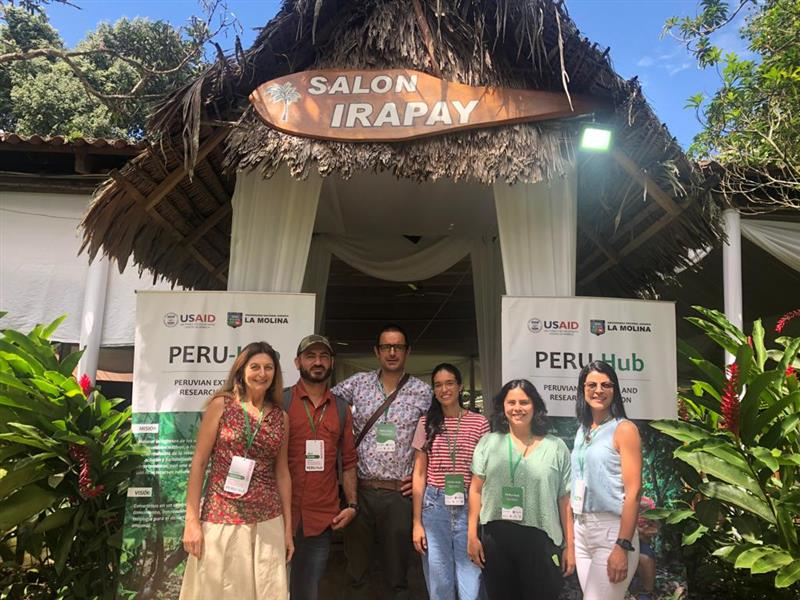Blog New Alliance project promotes cacao, silvopastoral systems in Peru

The Alliance is collaborating with universities in Peru and the United States in a new USAID-funded project called “Bringing Research to Impact for Development: Global Engagement and Utilization” (PERU-Hub).
Peru’s San Martín is home to more than 800,000 people, most of whom derive their relatively modest incomes from agriculture. Famous for its Huallaga River, which descends treacherously from the Andes and empties into the Amazon, the remote region was known decades ago for coca cultivation – much of it for the illicit drug trade. Recently coca cultivation is again on the rise. This is a potential threat to indigenous communities and the Amazon rainforest, which is sometimes cleared for cultivation.
A new project funded by USAID and led by the Universidad Nacional Agraria La Molina (UNALM, Peru’s national agrarian university), seeks to promote alternative agricultural activities to diminish the incentives of coca cultivation in the region. In addition to water availability and suitable growing areas, San Martín is rich in tropical forest diversity, including cacao and other fruits, which, if produced sustainably, can become a viable source of income for smallholder farmers.
The project, called Peruvian Extension and Research Utilization (PERU-Hub), seeks to generate economic development through agricultural diversification and technology transfer. Technology transfer will include post-harvest handling, food processing, capacity building, agricultural extension, and the promotion of entrepreneurship. This falls under a USAID grant program aimed at scaling up adoption of evidence-based actions that can improve livelihoods called “Bringing Research to Impact for Development: Global Engagement and Utilization,” or BRIDGE-U.
PERU-Hub has a $15 million USD budget and will roll out over five years. The project was officially launched in October 2021 and included the participation of Alliance researchers who are involved in the project.
The Alliance’s role
The Alliance of Bioversity International and CIAT will be involved in four areas of the project: cacao production, silvopastoral systems, weather information monitoring and climate change, and entrepreneurial promotion.
Yovita Ivanova, a senior manager in the Alliance’s Multifunctional Landscapes research area, will lead the Alliance’s work. She explains:
“PERU-Hub is about sustainable, alternative development in the region,” Ivanova said. “It’s an example of how research institutions, development agencies, universities and farmers can work together to improve socioeconomic conditions and increase the productivity of agroecological landscapes while reducing environmental impact.
“The project is also a great example of researchers building upon, and bringing together, their earlier work at Bioversity International and the International Center for Tropical Agriculture before the formation of the Alliance.”
Ivanova’s team, with support from the Climate Action research area, will focus on the following four facets of PERU-Hub.
- Cacao crop management. The Alliance will support the development of demonstrative plots of cacao that will include a variety of promising varieties for national and international markets. As part of the center of origin of cacao, Peru has a high diversity of cacao trees adapted to different environments. Alliance scientists are working on cacao in several projects, including increasing the production of high-value beans that are coveted by European chocolate producers.
- Silvopastoral management. The Alliance will support the development of demonstrative plots for silvopastoral systems, where trees, shrubs and improved grasses are integrated into livestock systems. These plots will showcase how these systems increase milk production and decrease the use of fertilizers and animal feed to make farming more profitable. Silvopastoral systems can also reduce the emission of planet-heating gases such as methane and nitrous oxide, while healthier soils lock in carbon that would otherwise be contributing to global warming.
- Weather information and climate change monitoring. The Alliance will provide locally tailored agro-climatic forecasts to help farmers plan for weather variation and adapt to climate change. The system will generate seasonal and long-term forecasts and corresponding recommendations that are disseminated widely to producers. This work builds on the CGIAR’s long-running work on providing climate information to farmers through local farmer committees.
- Entrepreneurship. PERU-Hub’s entrepreneurship program through UNALM’s business incubator. The goal is to foster the sustainable use of biodiversity and create economic opportunities, especially for women and youth, through the creation of small and mid-sized enterprises. Business models will be redesigned with extended financial, social, and environmental benefits and presented to impact investors, and other public and private financial entities. The Alliance will be responsible for events that bring together impact investors, social lenders and promising businesses.

Follow the project on Instagram.
“This comprehensive set of activities, in conjunction with PERU-Hub’s other activities, is designed to work with communities to improve livelihoods and the environment,” says Ivanova. “This project’s success will be measured by diversity of sustainable economic opportunities that can be developed for San Martín’s agrarian communities.”
PERU-Hub’s other main partners include the University of Oklahoma, Purdue University and Utah State University.
Go to the project website:
